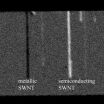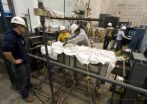(Press-News.org) Hair clippings, cayenne pepper and raw eggs – these are just a few of the odd ingredients recommended to keep those pesky deer away from your backyard garden. But what about farmers who have hundreds of acres of Christmas trees to protect? North Carolina State University extension specialists have now found an effective, inexpensive alternative to available commercial products to keep the deer at bay.
The NC State researchers, led by Jeff Owen, a Christmas-tree production specialist, are exploring the use of inexpensive, inedible food byproducts – such as dried blood and egg powder – typically sold in bulk to the pet-food industry to be used for flavoring. These byproducts cost 85 to 90 percent less than their commercial counterparts, and are found to be just as effective. Using these repellents – which can be purchased locally in bulk – may provide tree farmers an early Christmas present.
"These products have an unappealing taste, but the decaying smell actually elicits a fear response in the deer and keeps them away from the crops," Owen says. "We're continuing to look at similar products – like liver powder and fishmeal – to see if they work the same way."
Owen says that Christmas-tree farms in North Carolina have long dealt with deer who harm the trees by horning (thrashing market-sized trees with their antlers to mark territory) and browsing (eating the buds and shoots off young trees.) Not all Fraser fir growers contend with these problems, but where deer populations are high, deer can eat young trees down to a pencil-sized stem. Damage can be so extensive that growers have abandoned fields of young trees. Hard-pressed growers will use a combination of selective hunting, deer repellents and food plots to divert deer from their trees.
"We initially looked into the effectiveness and feasibility of using different fencing and commercial repellents to protect trees and crops from deer. Both are successful, but are extremely expensive," Owen explains. "When you take the commercial deer repellent that you find at your local hardware store and use it on a farmwide basis, you see growers budgeting as much for deer repellents as most of their other pesticides." Commercial deer repellents are so costly that Christmas tree growers use them at half-strength to be able to afford using them at all.
According to Owen, commercial deer repellents cost at least $18 per pound, while the dried blood or egg powder, which can be bought in bulk from agriculture suppliers, runs less than $2 per pound. When you consider that growers use 10 pounds per acre and make two or three applications over the fall and winter, the savings are significant.
"The threat of deer is very important to our local growers, since the impact of their browsing and horning can cost thousands of dollars in lost product and increased expense. And with the economy in the state it is, the growers can't pass expenses associated with deer damage onto the consumer, because the wholesale market would not support it," Owen says. "So, the deer have been, literally, eating into their profit. We hope that finding an inexpensive deer repellent alternative will not only help save their crop, but also help them to stay profitable."
But before the home gardener runs to place orders for rancid egg powder, Owen offers some words of wisdom.
"Our growers get these products in 50-pound bags or even 2,000-pound pallets, and have to mix the egg powder or dried blood into a solution to be sprayed. It's not the prettiest process," laughs Owen. "For the average homeowner, the pre-made commercial deer repellent should be more than adequate, provided you rotate repellents from time to time."
INFORMATION:
NC State and the N.C. Christmas Tree Association provided support for the research.
Back off, Rudolph: Protecting this year's Christmas tree crop
2010-11-17
ELSE PRESS RELEASES FROM THIS DATE:
Imaging tool may aid nanoelectronics by screening tiny tubes
2010-11-17
WEST LAFAYETTE, Ind. - Researchers have demonstrated a new imaging tool for rapidly screening structures called single-wall carbon nanotubes, possibly hastening their use in creating a new class of computers and electronics that are faster and consume less power than today's.
The semiconducting nanostructures might be used to revolutionize electronics by replacing conventional silicon components and circuits. However, one obstacle in their application is that metallic versions form unavoidably during the manufacturing process, contaminating the semiconducting nanotubes.
Now ...
Engineers test effects of fire on steel structures
2010-11-17
WEST LAFAYETTE, Ind. - Researchers at Purdue University are studying the effects of fire on steel structures, such as buildings and bridges, using a one-of-a-kind heating system and a specialized laboratory for testing large beams and other components.
Building fires may reach temperatures of 1,000 degrees Celsius, or more than 1,800 degrees Fahrenheit, said Amit Varma, a Purdue associate professor of civil engineering who is leading the work.g1
"At that temperature, exposed steel would take about 25 minutes to lose about 60 percent of its strength and stiffness," he ...
Organ network uses Carnegie Mellon algorithm to match live kidney donors with recipients
2010-11-17
PITTSBURGH—A computer algorithm developed at Carnegie Mellon University matched living kidney donors with medically compatible transplant candidates late last month as the national Organ Procurement and Transplantation Network (OPTN), operated by the United Network for Organ Sharing (UNOS), began a national pilot program to increase the number of kidney paired-donation (KPD) transplants.
The initial run of the computer matching process included just 43 kidney transplant candidates and 45 potential living donors, but a national KPD pool eventually could include as many ...
International discussions on FRAX smooth the way for implementation in clinical practice
2010-11-17
Three days of critical international discussion and debate, led by a panel of experts from the International Society of Clinical Densitometry (ISCD) and the International Osteoporosis Foundation (IOF), have served to clarify a number of important questions pertaining to the interpretation and use of FRAX® in clinical practice.
The WHO Fracture Risk Assessment Tool (FRAX®), with models for some 26 countries, is an important new online tool that is being used by a steadily increasing number of physicians around the world. FRAX® is country-specific and calculates a patient's ...
Heart surgeries can trigger strokes, seizures and other neurological complications
2010-11-17
Strokes, seizures and other neurological complications related to heart surgery account for "considerable morbidity and mortality," Loyola University Health System neurologists report in the November issue of the journal Hospital Practice.
Other complications include delirium, central nervous system infections, pituitary gland problems, spinal cord or peripheral nerve injuries, residual effects of anesthesia and medication toxicity.
Complications can involve any part of the central and peripheral nervous systems. "Neurologic complications are always a risk with cardiac ...
Depression linked to HIV risk among South African young people, study shows
2010-11-17
University of Alberta research has discovered a strong link between depression and risky sexual behaviours such as improper condom use, transactional sex and relationship violence among young people in South Africa.
The research shows that depression is common among young South Africans, and could be making a significant contribution towards the HIV epidemic.
As well, the researchers believe that depression could be contributing to risky sexual behaviours around the world, and that preventing or treating it may reduce the global burden of sexually transmitted diseases, ...
Listening for ocean spills and their ecological effects
2010-11-17
November 16, 2010 -- Scientists who study acoustics (the "science of sound") have over the years developed a variety of techniques to probe the hidden depths of oceans. This week, many of these acoustic researchers will come together to discuss how these technologies were used to monitor April's Deepwater Horizon oil spill, to present new data on the gusher's ecological impacts, and to highlight new techniques under development that could improve our ability to detect oil in ocean water.
This special session will take place on November 17, 2010 at the 2nd Pan-American/Iberian ...
Research links damaged organs to change in biochemical wave patterns
2010-11-17
By examining the distinct wave patterns formed from complex biochemical reactions within the human body, diseased organs may be more effectively identified, says Zhengdong Cheng, associate professor in the Artie McFerrin Department of Chemical Engineering at Texas A&M University, who has developed a model that simulates how these wave patterns are generated.
His findings, which appear in the October issue of the journal "Physical Review E," detail Cheng's work with a system designed to model cells in a biochemical environment, similar to what occurs inside the human body.
His ...
Study rewrites the evolutionary history of C4 grasses
2010-11-17
CHAMPAIGN, Ill. — According to a popular hypothesis, grasses such as maize, sugar cane, millet and sorghum got their evolutionary start as a result of a steep drop in atmospheric carbon dioxide levels during the Oligocene epoch, more than 23 million years ago. A new study overturns that hypothesis, presenting the first geological evidence that the ancestors of these and other C4 grasses emerged millions of years earlier than previously established.
The findings are published in the journal Geology.
C4 plants are more efficient than C3 plants at taking up atmospheric ...
Program for young students increases interest in college attendance and medical careers
2010-11-17
Two new studies have shown that a unique program in East Harlem that helps middle school students learn practical health skills and gain a better understanding of medical conditions, such as diabetes and hypertension, resulted in increased interest in college attendance and medical careers among the students who attended the program. The results were presented at the American Public Health Association (APHA) Annual Meeting this month in Denver.
The MedStart Summer Enrichment Program was created in the summer of 2009 by Edward Chu and Melissa Schneiderman, two third-year ...



